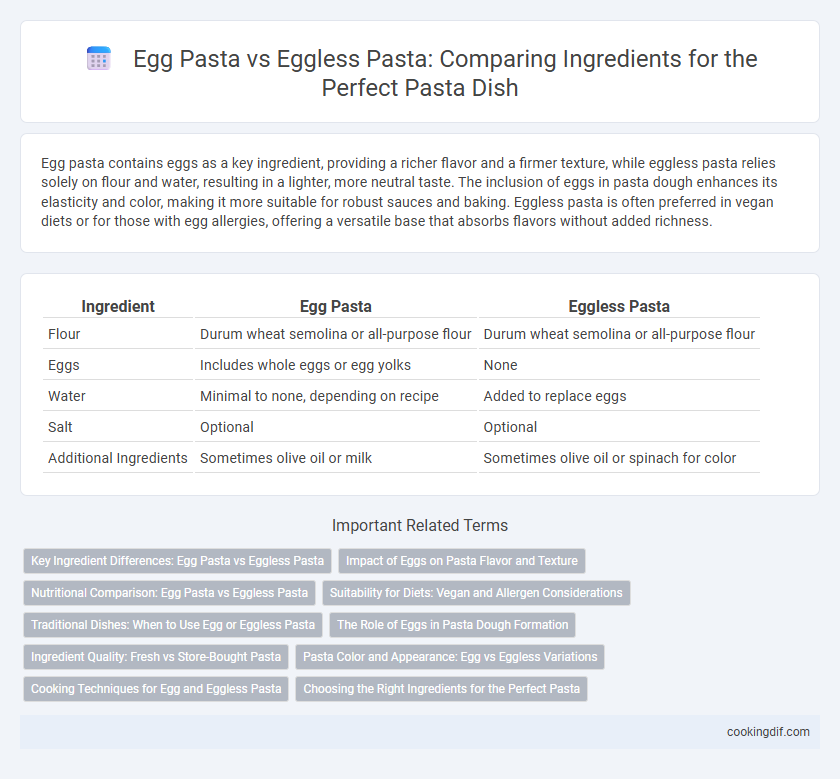Egg pasta contains eggs as a key ingredient, providing a richer flavor and a firmer texture, while eggless pasta relies solely on flour and water, resulting in a lighter, more neutral taste. The inclusion of eggs in pasta dough enhances its elasticity and color, making it more suitable for robust sauces and baking. Eggless pasta is often preferred in vegan diets or for those with egg allergies, offering a versatile base that absorbs flavors without added richness.
Table of Comparison
| Ingredient | Egg Pasta | Eggless Pasta |
|---|---|---|
| Flour | Durum wheat semolina or all-purpose flour | Durum wheat semolina or all-purpose flour |
| Eggs | Includes whole eggs or egg yolks | None |
| Water | Minimal to none, depending on recipe | Added to replace eggs |
| Salt | Optional | Optional |
| Additional Ingredients | Sometimes olive oil or milk | Sometimes olive oil or spinach for color |
Key Ingredient Differences: Egg Pasta vs Eggless Pasta
Egg pasta contains eggs as a primary ingredient, providing a richer flavor, smoother texture, and higher protein content compared to eggless pasta. Eggless pasta is typically made from just durum wheat semolina and water, resulting in a firmer, chewier bite and a lighter color. These key ingredient disparities influence cooking times, nutritional profiles, and taste preferences in various pasta dishes.
Impact of Eggs on Pasta Flavor and Texture
Egg pasta contains whole eggs or egg yolks, contributing to a richer flavor and a firmer, silkier texture compared to eggless pasta. The proteins and fats in eggs enhance dough elasticity, resulting in pasta that holds sauces better and has a more tender bite. Eggless pasta, typically made from semolina and water, offers a neutral taste and a slightly chewier texture, making it ideal for robust sauces and vegan diets.
Nutritional Comparison: Egg Pasta vs Eggless Pasta
Egg pasta contains higher protein and fat content due to the inclusion of whole eggs, providing essential amino acids and vitamins like vitamin A and B12. Eggless pasta, typically made from flour and water, offers a lower calorie and fat profile, making it suitable for vegan diets and those seeking reduced cholesterol intake. Both types supply carbohydrates for energy, but egg pasta generally delivers more nutrient density per serving.
Suitability for Diets: Vegan and Allergen Considerations
Egg pasta contains eggs, making it unsuitable for vegan diets and individuals with egg allergies, while eggless pasta uses only wheat flour and water, catering to vegans and those with egg sensitivities. Eggless pasta often serves as an allergen-friendly option, minimizing risks associated with egg intolerance or allergy. Choosing eggless pasta supports plant-based dietary preferences and allergen-conscious meal planning.
Traditional Dishes: When to Use Egg or Eggless Pasta
Egg pasta, made with wheat flour and eggs, offers a richer texture and flavor ideal for traditional Italian dishes like tagliatelle al ragu and fresh ravioli, where a tender yet firm bite is desired. Eggless pasta, typically crafted from semolina or durum wheat flour and water, suits vegan recipes and dishes requiring a neutral base, such as aglio e olio or vegetable-based sauces. Choosing between egg and eggless pasta depends on the recipe's authenticity and dietary needs, with egg pasta favored in classic rich sauces and eggless preferred for lighter or vegan preparations.
The Role of Eggs in Pasta Dough Formation
Egg pasta dough relies on the proteins and emulsifying properties of eggs to create a rich, elastic texture and vibrant color, enhancing the dough's structure and flavor. Eggless pasta uses water and flour alone, resulting in a firmer, chewier consistency with a more neutral taste, ideal for holding heavier sauces. The presence of eggs influences gluten development and moisture retention, making egg pasta more tender and pliable compared to eggless varieties.
Ingredient Quality: Fresh vs Store-Bought Pasta
Egg pasta is typically made with fresh, high-quality ingredients such as farm-fresh eggs and finely milled durum wheat semolina, resulting in a richer flavor and tender texture. Eggless pasta often relies on store-bought dried flour blends and water, which can lead to a firmer bite and less nuanced taste due to lower moisture and absence of egg proteins. The ingredient quality in egg pasta contributes to superior elasticity and a more delicate mouthfeel compared to the denser texture of eggless varieties.
Pasta Color and Appearance: Egg vs Eggless Variations
Egg pasta features a rich yellow hue and a smooth, slightly glossy surface due to the natural pigments in egg yolks and the fats they contain. Eggless pasta tends to have a lighter, paler cream or white color, often appearing matte because it relies solely on flour and water without the enriching pigments and fats eggs provide. The color differences influence the visual appeal and perceived freshness, with egg pasta often preferred for its vibrant look and smoother texture.
Cooking Techniques for Egg and Eggless Pasta
Egg pasta requires gentle handling during cooking to prevent breakage, as the protein-rich dough is more delicate and benefits from shorter boiling times of 2-4 minutes. Eggless pasta, often made from semolina and water, is sturdier and tolerates longer cooking times, typically 7-12 minutes, resulting in a firmer texture. Techniques such as resting the dough before rolling enhance gluten development in eggless pasta, improving elasticity and chewiness, while egg pasta dough relies on the richness of eggs to provide structure and moisture without extensive kneading.
Choosing the Right Ingredients for the Perfect Pasta
Egg pasta typically contains wheat flour and fresh eggs, providing a rich flavor and tender texture ideal for silkier sauces. Eggless pasta relies on just wheat flour and water, offering a lighter, more neutral base suited for robust, tomato-based or vegetable sauces. Selecting the right pasta depends on the desired texture and sauce pairing, with egg pasta enhancing creaminess and eggless pasta allowing the sauce to shine.
Egg pasta vs eggless pasta for ingredients Infographic

 cookingdif.com
cookingdif.com